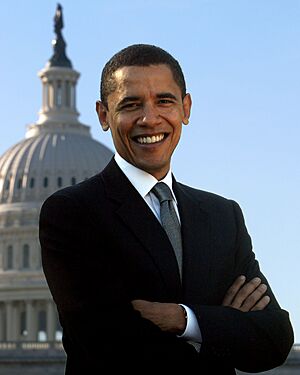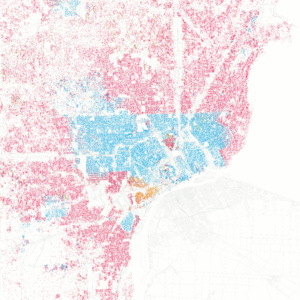Post-racial America facts for kids
The idea of a post-racial United States means a future where the United States no longer has problems like racism, discrimination, or unfair treatment based on a person's race. It's a goal where everyone is treated equally, no matter their background.
Contents
When Did the Term "Post-Racial" Start?
One of the first times the word "post-racial" was used to describe the United States was in a newspaper article. This article appeared in The New York Times on October 5, 1971. It was titled "Compact Set Up for 'Post-Racial' South".
The article talked about a group called the "Southern Growth Policies Board". This group was formed in Durham, North Carolina. About 70 politicians and professors believed that the Southern states were entering a new time. They thought that race relations would soon be less important. Instead, they believed that population growth and economic development would become the main concerns.
The 2008 Presidential Election and Race
When Barack Obama ran for president and won in 2008, some people saw it as a big step. He became the first black president of the United States. For some, this meant that the country had become "post-racial."
For example, Lou Dobbs, a radio host, said in 2009 that America was now a "post-racial society." Another host, Chris Matthews, even said he "forgot [Obama] was black" for an hour.
Different Views on Race in America
However, not everyone agreed that the United States was post-racial. People's opinions often depended on their own race.
A poll in 2014 showed this difference. About half of white people thought the justice system treated all races equally. But only 10% of African-Americans felt the same way.
In 2015, another poll found that 13% of black Americans thought race relations were the biggest problem in the U.S. Only 4% of white Americans felt this way.
Race and the Justice System
Many people who say America is not post-racial point to how African-Americans are treated. This includes their experiences with the criminal justice system and the police.
There have been many widely reported cases of unarmed African-Americans dying during interactions with police officers. A study in 2015 found that police officers in the U.S. killed 7.13 black Americans per million people. This was much higher than the 2.91 white Americans per million.
The study also found that young black men were much more likely to be killed by police. They were nine times more likely than other Americans in 2015. Even though they made up only 2% of the U.S. population, black males aged 15 to 34 accounted for over 15% of all deaths caused by law enforcement that year.
These events greatly changed how people viewed race relations in America. The number of black Americans who saw race relations as a major problem jumped from 3% in early 2014 to 13% in 2015. For white Americans, it rose from 1% to 4%.
The "Black Lives Matter" Movement

After several high-profile incidents, many scholars and journalists spoke out. They argued against the idea that America was post-racial. Ta-Nehisi Coates wrote in 2015 that "post-racial" was a term often used by TV hosts. Anna Holmes wrote that the history of slavery still affects American society. She felt that the wish for a "post-racial" America might be a way for white people to avoid dealing with that difficult past.
The different views on race were also seen in reactions to the Black Lives Matter movement. This movement started to highlight unfair treatment of black people. Some people responded by saying "all lives matter."
For example, after a sheriff's deputy was killed in Texas, Sheriff Ron Hickman said that the Black Lives Matter movement's words had contributed to the killing. He said, "All lives matter. Well, cops' lives matter, too."
Supporters of Black Lives Matter disagreed with "all lives matter." They argued that it ignored the specific threats faced by African-Americans. President Obama said that there is a "specific problem" happening in the African-American community. Andrew Rosenthal also wrote that "Black Lives Matter" means that African-Americans' lives have been under special threat for a long time.
Racial Divisions in Cities
There is also evidence of continued racial divisions in how people live. For example, African-Americans make up less than 15% of the total population of Michigan. But they are over 82% of the population in Detroit, Michigan's largest city. Many cities with mostly black residents often have separate schools, less tax money, and fewer public services.
A similar situation is seen in Louisiana. The state was about 64% white in 2010. But its largest city, New Orleans, is 60% black. Even within New Orleans, there is more separation. The Lower Ninth Ward, for example, is 97% black.
This neighborhood was hit hardest by flooding after Hurricane Katrina. Many people pointed to the government's response to the disaster as proof of ongoing racism. Most of the victims were black and poor. Wealth played a big role in who survived. Those who lived in safer areas or could leave before the storm were usually wealthier. President George W. Bush admitted that this poverty came from a history of racial discrimination.
How "Post-Racial" Ideas Affect Politics
The idea that America is "post-racial" has even influenced decisions by the U.S. Supreme Court.
In 2013, in a case called Shelby County v. Holder, the Court made a ruling. It said that a part of the Voting Rights Act of 1965 was no longer needed. This part had required nine states with a history of racial discrimination to get federal approval for changes to their election laws.
Chief Justice John G. Roberts Jr. wrote that "Our country has changed." He said that voting tests were gone, and black Americans were voting and holding office in record numbers. He felt the law was based on old problems, not current ones.
Another case, Fisher v. University of Texas, also dealt with similar issues. This case challenged affirmative action policies. These policies aim to help groups that have faced discrimination. In 2016, the Court upheld the University of Texas's policy, which considered race in admissions.
People who disagree with the "post-racial" idea say it ignores racial problems that still exist today. Harvard scholar Lawrence D. Bobo believes that racism is still present in subtle ways.
See also
- Color blindness (race)
- Rainbow nation in South Africa
- Racial democracy in Brazil



